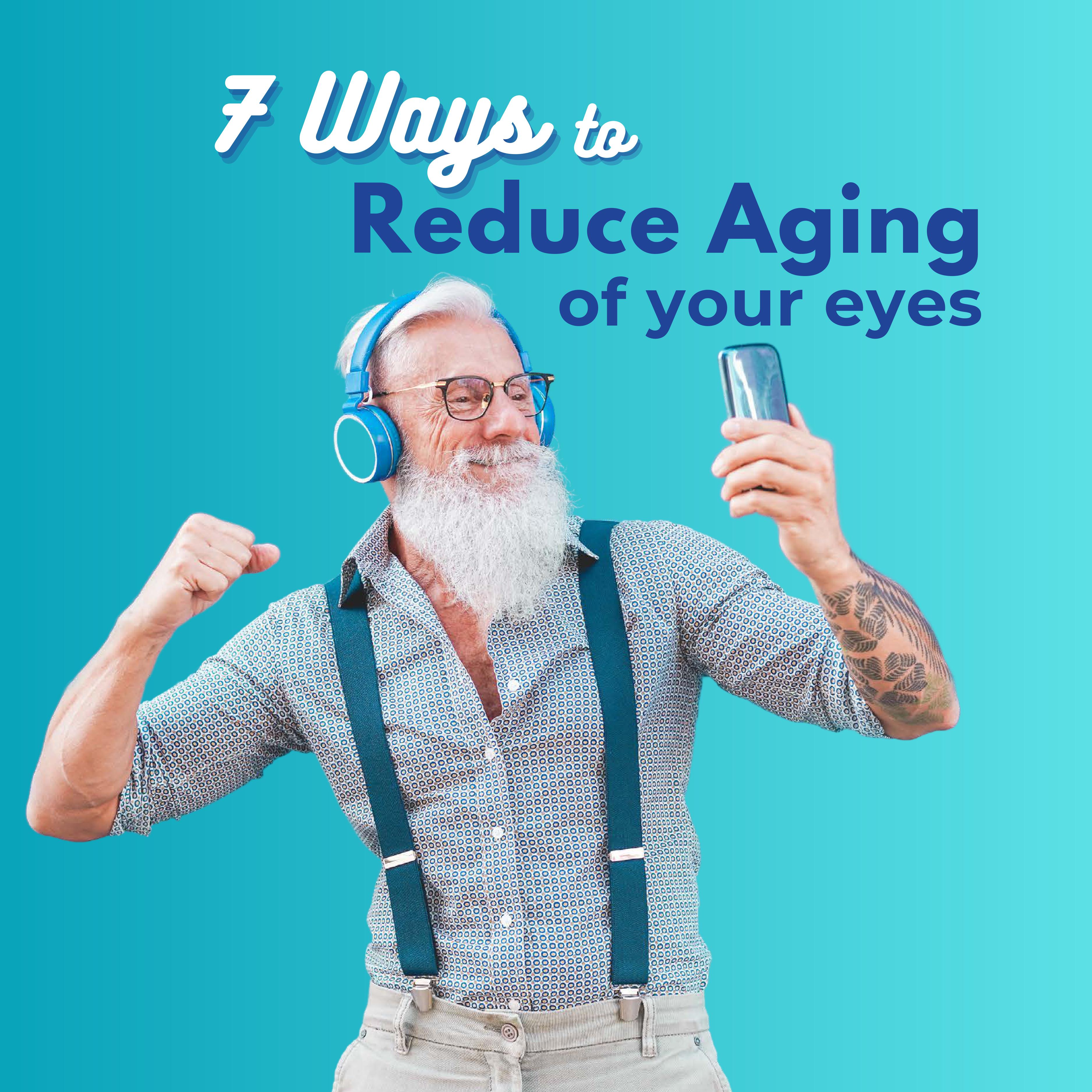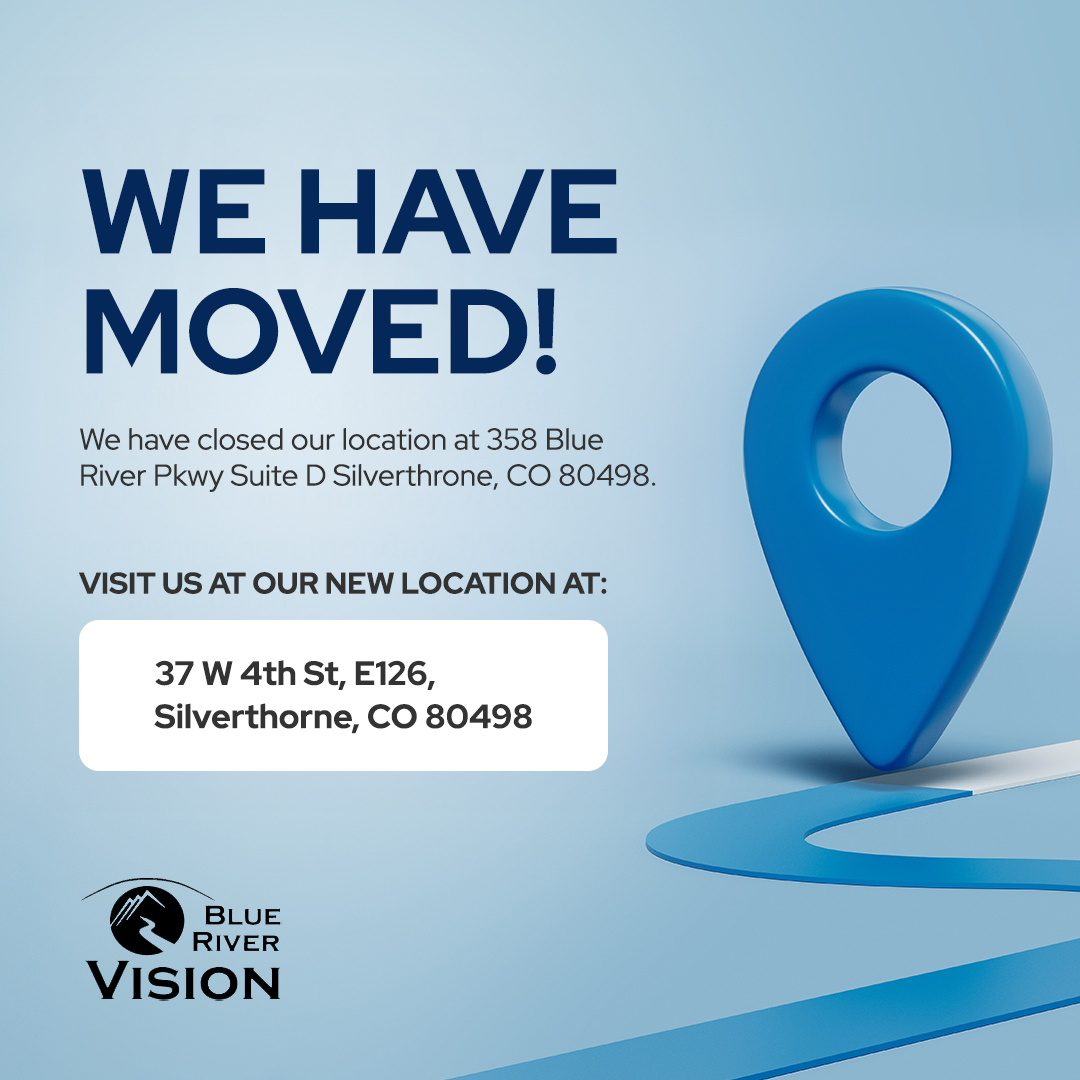
Spoiler alert… We’re giving you the best way to reduce aging of the eyes up front. Ready?
Form healthy habits early on in life! But if you’re not in your early days of life then Blue River Vision has seven ways for you to get yourself on track to protecting your vision and eye health through your lifespan.
There are several common habits that speed up the aging process for your eyes. Some habits are easier to break than others. Many individuals start with changing one or two smaller habits that seem easier to modify. Other people begin by breaking a bigger habit to create a greater positive impact on their health. Regardless of the change you choose to make being big or small, the choice to live healthier today can slow your eye aging process in years to come. Colorado optometrists recommend incorporating all seven tips as a way to safeguard our vision as we age.
“Taking care of your eye health early in life does a lot to preserve your vision later in life. Many eye health consequences that people experience from smoking or obesity are not reversible. We want to make sure Coloradans know how to maintain healthy vision now and to reduce risky habits that increase eye health challenges in later years. A great first step is to come in and get an annual comprehensive eye exam to detect eye health issues before any symptoms occur,” says Dr. Tom Cruse, Board President at Colorado Optometric Association.
7 High Impact Ways to Reduce Eye Aging
Taking Sun Exposure Seriously
Sun exposure can increase your risk of cataracts and if you have blue eyes and fair skin your risk of cataracts is even higher. Once sun damage of the eye occurs, the long term impact is not reversible making sun glasses more important than most people think. The Colorado sun is bright due to the elevation and the intense sun reflecting off of snow or water. Grab a pair of 100% UVA/UVB blocking sunglasses to safeguard your eye health and wear them when outside. Pair your sunglasses with a hat for even more UV protection since sunlight can slip in through the side of your glasses. Start your kids off right by protecting their eyes early on. Bonus: tiny sunglasses are cute!
Regular Exercise Regular exercise is helpful across the board for your general health, but it’s also essential for keeping your vision from diminishing. One study of more than 15,000 people discovered that individuals who exercised and drank occasionally had less vision loss over a 20-year period than individuals who did not exercise and did not drink.1 This finding outlines the importance of exercise. Find the exercise that works for you whether it’s walking, hiking, running, swimming, weightlifting, or the countless other ways to get movement in.
Nutrient Dense Food Choices
When choosing what to eat throughout your day make sure you’re getting the nutrients that promote healthy eyes. To support your eye health and reduce eye disease risks choose foods rich in vitamins C and E, zinc, lutein, zeaxanthin, and omega-3 fatty acids DHA and EPA. These foods include (but are not limited to) dark green leafy vegetables, dark berries and wild salmon. If you have already been diagnosed with an eye disease check with your optometrist to understand which foods can support your eye health and which foods can provoke your symptoms or even speed up the progression of the disease.
Get a Comprehensive Eye Exam Annually
It’s simple, just because you don’t have any symptoms does NOT mean you should skip your annual comprehensive eye exam. Many vision threatening eye diseases such as glaucoma, macular degeneration, cataracts, or diabetic retinopathy have no or minimal symptoms until the disease has progressed. Early detection is key to slowing progress, managing disease, and saving vision.
I look at a lot more than just your vision acuity in a comprehensive exam and can even detect other health issues such as; autoimmune conditions, allergies, medication complications, high blood pressure, high cholesterol, diabetes and more.
Eye Exam Frequency for Low Risk Patients:
Birth – 2 years: Exam at 6 to 12 months of age
3 – 5 years: At least once between 3 and 5 years of age
6 – 17: Before first grade and annually thereafter
18 – 39: Every 1-2 years
40 and older: Every 1-2 years
65 and older: Annually
Eye Exam Frequency for At-risk Patients:
Birth – 2 years: Exam at 6 to 12 months of age
3 – 5 years: At least once between 3 and 5 years of age
6 – 17: Before first grade and annually thereafter
18 – 39: At least annually or as recommended
40 – 64: At least annually or as recommended
65 and older: At least annually or as recommended
At Risk Patients Include:
- A personal or family history of ocular disease.
- Certain racial and ethnic groups can have predispositions to eye health conditions.
- Systemic health conditions with potential ocular manifestations, for example, high blood pressure, high cholesterol and diabetes.
- Occupations that are highly demanding visually or have a high potential of being hazardous to the eyes.
- Taking prescription or nonprescription drugs with ocular side effects.
- Functional vision in only one eye.
- Wearing contact lenses.
- Eye surgery or previous eye injury.
- High or progressive refractive error.
- Other eye-related health concerns or conditions.
Patients who have undergone refractive surgery (LASIK, PRK, SMILE) should still have an eye exam every 1-2 years for monitoring of overall ocular health.1
Quit Smoking or Don’t Start
The truth is that smoking tobacco increases the risk of age-related macular degeneration (ARMD), cataracts, glaucoma, diabetic retinopathy and Dry Eye Syndrome. Many of these diseases can lead to vision loss or blindness. ARMD is the leading cause of blindness and studies show that smokers have up to four times the risk of developing ARMD. If you’ve been unsuccessful at smoking cessation keep trying and get support such as using the Colorado QuitLine, a free support program for Colorado residents. Call 1-800-QUIT-NOW or Enroll today.
Maintain a Healthy Weight
Being overweight or obese increases your risk of Age-related Macular Degeneration, cataracts and glaucoma. Unfortunately, losing the weight does not lower your increased risk for cataracts, which makes maintaining a healthy weight important.
Being underweight also jeopardizes eye health due to vitamin deficiencies, decreased sleep and immune function, as well as, causing growth and development issues in kids.
If you need assistance with weight control for any reason talk to your primary care physician. Your doctor can rule out any underlying medical issues.
Calculate your BMI and learn more about healthy weight maintenance.
Control Blood Pressure Regardless of your current health status check your blood pressure every few months. High blood pressure is known as “the silent killer.” Many people don’t know they have elevated blood pressure until it’s too late and they’ve suffered a health issue like a stroke or permanent loss of vision.
Healthy Blood Pressure Levels:
- Normal (less than 120/80) continue to check it every few months.
- Elevated (120-139/80-89 or higher). See your primary care physician and get a comprehensive eye exam from your optometrist to rule out eye health conditions.
- Possible medication needed if (systolic) is over 140 or your bottom number (diastolic) is over 90. See your primary care physician and get a comprehensive eye exam from your optometrist to rule out eye health conditions.
1 https://www.hopkinsmedicine.org/health/wellness-and-prevention/best-way-to-age-proof-your-vision
2 https://www.aoa.org/healthy-eyes/caring-for-your-eyes/eye-exams?sso=y





